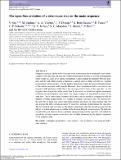Files in this item
The open flux evolution of a solar-mass star on the main sequence
Item metadata
| dc.contributor.author | See, V. | |
| dc.contributor.author | Jardine, M. | |
| dc.contributor.author | Vidotto, A. A. | |
| dc.contributor.author | Donati, J. -F. | |
| dc.contributor.author | Saikia, S. Boro | |
| dc.contributor.author | Fares, R. | |
| dc.contributor.author | Folsom, C. P. | |
| dc.contributor.author | Jeffers, S. V. | |
| dc.contributor.author | Marsden, S. C. | |
| dc.contributor.author | Morin, J. | |
| dc.contributor.author | Petit, P. | |
| dc.contributor.author | BCool Collaboration | |
| dc.date.accessioned | 2018-02-26T15:30:14Z | |
| dc.date.available | 2018-02-26T15:30:14Z | |
| dc.date.issued | 2018-02-11 | |
| dc.identifier | 252395106 | |
| dc.identifier | 2bb398c3-fd28-4d34-b7e8-7e881c13ff90 | |
| dc.identifier | 000424339500037 | |
| dc.identifier | 85042710993 | |
| dc.identifier | 000424339500037 | |
| dc.identifier.citation | See , V , Jardine , M , Vidotto , A A , Donati , J -F , Saikia , S B , Fares , R , Folsom , C P , Jeffers , S V , Marsden , S C , Morin , J , Petit , P & BCool Collaboration 2018 , ' The open flux evolution of a solar-mass star on the main sequence ' , Monthly Notices of the Royal Astronomical Society , vol. 474 , no. 1 , pp. 536-546 . https://doi.org/10.1093/mnras/stx2599 | en |
| dc.identifier.issn | 0035-8711 | |
| dc.identifier.other | ORCID: /0000-0002-1466-5236/work/57821881 | |
| dc.identifier.uri | https://hdl.handle.net/10023/12787 | |
| dc.description | VS acknowledges support from a Science & Technology Facilities Council (STFC) post-doctoral fellowship and the European Research Council Consolidator grant AWESoMeStars. SBS and SVJ acknowledge research funding by the Deutsche Forchungsgemeinschaft (DFG) under grant SFB, project A16. RF acknowledges financial support by WOW from INAF through the Progetti Premiali funding scheme of the Italian Ministry of Education, University, and Research. This study was supported by the grant ANR 2011 Blanc SIMI5-6 020 01 ‘Toupies: Towards understanding the spin evolution of stars’ (http://ipag.osug.fr/Anr_Toupies/). | en |
| dc.description.abstract | Magnetic activity is known to be correlated to the rotation period for moderately active main-sequence solar-like stars. In turn, the stellar rotation period evolves as a result of magnetized stellar winds that carry away angular momentum. Understanding the interplay between magnetic activity and stellar rotation is therefore a central task for stellar astrophysics. Angular momentum evolution models typically employ spin-down torques that are formulated in terms of the surface magnetic field strength. However, these formulations fail to account for the magnetic field geometry, unlike those that are expressed in terms of the open flux, i.e. the magnetic flux along which stellar winds flow. In this work, we model the angular momentum evolution of main-sequence solar-mass stars using a torque law formulated in terms of the open flux. This is done using a potential field source surface model in conjunction with the Zeeman-Doppler magnetograms of a sample of roughly solar-mass stars. We explore how the open flux of these stars varies with stellar rotation and choice of source surface radii. We also explore the effect of field geometry by using two methods of determining the open flux. The first method only accounts for the dipole component while the second accounts for the full set of spherical harmonics available in the Zeeman-Doppler magnetogram. We find only a small difference between the two methods, demonstrating that the open flux, and indeed the spin-down, of main-sequence solar-mass stars is likely dominated by the dipolar component of the magnetic field. | |
| dc.format.extent | 11 | |
| dc.format.extent | 618246 | |
| dc.language.iso | eng | |
| dc.relation.ispartof | Monthly Notices of the Royal Astronomical Society | en |
| dc.subject | Techniques: polarimetric | en |
| dc.subject | Stars: activity | en |
| dc.subject | Stars: evolution | en |
| dc.subject | Stars: magnetic field | en |
| dc.subject | Stars: rotation | en |
| dc.subject | QB Astronomy | en |
| dc.subject | QC Physics | en |
| dc.subject | NDAS | en |
| dc.subject.lcc | QB | en |
| dc.subject.lcc | QC | en |
| dc.title | The open flux evolution of a solar-mass star on the main sequence | en |
| dc.type | Journal article | en |
| dc.contributor.sponsor | Science & Technology Facilities Council | en |
| dc.contributor.sponsor | Science & Technology Facilities Council | en |
| dc.contributor.institution | University of St Andrews. School of Physics and Astronomy | en |
| dc.identifier.doi | https://doi.org/10.1093/mnras/stx2599 | |
| dc.description.status | Peer reviewed | en |
| dc.identifier.url | https://arxiv.org/abs/1711.03904 | en |
| dc.identifier.grantnumber | ST/R00824/1 | en |
| dc.identifier.grantnumber | ST/M001296/1 | en |
This item appears in the following Collection(s)
Items in the St Andrews Research Repository are protected by copyright, with all rights reserved, unless otherwise indicated.

